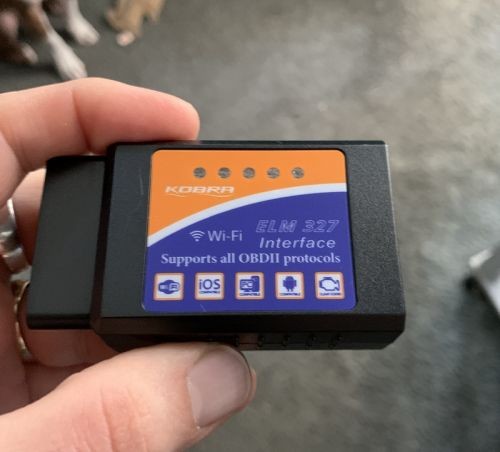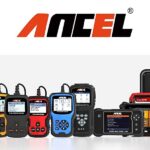Dealing with a check engine light can be frustrating, especially when your car has been recently serviced. Like many car owners, I was looking for a way to understand those cryptic error codes without immediately rushing to a mechanic. That’s when I decided to try an OBD2 scanner. After some research and recommendations, I opted for the Kobra OBD2 Scanner from Amazon, drawn in by its positive ratings (over 2700!) and promises of broad car model compatibility and a large code database. Could this affordable tool really empower me with car diagnostic insights? Let’s dive into my experience.
Alt text: Kobra OBD2 Scanner device displayed on a white background, highlighting its compact design for car diagnostics.
OBD2 scanners typically offer two connection types: Wi-Fi or Bluetooth. The Kobra scanner uses Wi-Fi, which is something to note for app compatibility. First things first, you’ll need to locate your car’s OBD-II port. It’s usually under the dashboard on the driver’s side. If you use a device for insurance tracking that plugs into this port, you’ll need to temporarily disconnect it to use the Kobra scanner.
Alt text: Locating the OBD-II port in a car, typically situated beneath the dashboard on the driver’s side for easy access with diagnostic tools.
Installation is straightforward – simply plug the Kobra OBD2 scanner into the OBD-II port. Once connected, it powers on and is ready to link with your smartphone. Since this model uses Wi-Fi, you’ll need to connect your phone to the scanner’s Wi-Fi network through your phone’s Wi-Fi settings.
Alt text: Smartphone screen displaying the Car Scanner ELM OBD2 app interface, showcasing Wi-Fi connection settings for OBD2 scanner communication.
The Kobra OBD Scanner claims compatibility with various car models from 1996 to 2016 and advertises support for numerous apps like OBD Fusion, DashCommand, and Torque. However, my experience revealed a different reality. Many popular OBD2 apps designed for Bluetooth scanners failed to recognize or connect to the Kobra Wi-Fi scanner. Apps like Garage Pro, FIXD, AutoDoctor, and Torque were incompatible. Frustratingly, the only app I found that worked reliably with the Kobra scanner on iOS was Car Scanner ELM OBD2. While other apps might work, be prepared for potential compatibility issues, especially if they primarily support Bluetooth connections.
Alt text: Connecting a smartphone via Wi-Fi to the Kobra OBD2 scanner, illustrating the initial setup for vehicle diagnostics.
The Car Scanner ELM OBD2 app, thankfully, does offer Wi-Fi connection options, and the default IP/port settings worked perfectly with the Kobra scanner. Once connected, the app provides a range of features including a dashboard, live data monitoring, sensor readings, and, crucially for me, diagnostic trouble codes. My primary goal was to decipher the check engine light, so I headed straight to the diagnostic section.
Alt text: Car Scanner ELM OBD2 app dashboard displaying real-time vehicle data such as engine RPM, speed, and coolant temperature.
Beyond error codes, the app offers real-time data displays. You can monitor your engine RPM, speed, and temperature in real-time.
The app also provides insights into driving data, including drive time, fuel usage, and fuel consumption.
Alt text: Car Scanner ELM OBD2 app interface showing vehicle voltage information, a useful metric for car battery and electrical system monitoring.
You can also check voltage readings, which can be helpful for monitoring your car’s electrical system. When I ran a scan for error codes, the Kobra scanner and app identified codes P2004, P0128, P0522, and P0856. The P0856 code turned out to be a false reading (“inhibited test”). After clearing the codes and restarting my car, the persistent culprit was P2004, indicating an “intake manifold air control actuator stuck open” issue. Looking up this code provided valuable information about the problem and estimated repair costs from various sources.
This knowledge was empowering. Armed with the diagnostic information and repair cost estimates, I visited my mechanic. I didn’t reveal that I had already scanned the car. This allowed me to compare their diagnosis and price quote with my own findings. While the Kobra scanner didn’t directly save me money on the repair, it gave me a sense of control and allowed me to understand the issue’s urgency. Since the error wasn’t critical, I could schedule the repair when it better fit my budget.
The Kobra OBD-II Scanner is available on Amazon for a budget-friendly price of around $20.99, and it can potentially save you significantly more than its cost by providing valuable diagnostic information. My main drawback was the limited app compatibility compared to its claims. Finding a compatible app took some trial and error.
Alt text: Amazon “Buy Now” button, encouraging purchase of the Kobra OBD2 scanner for vehicle diagnostics and troubleshooting.
In conclusion, the Kobra OBD2 scanner offers a low-cost entry point into car diagnostics. While its app compatibility isn’t as broad as advertised, and it may require some effort to find a suitable app like Car Scanner ELM OBD2, it delivers on its core function: reading and interpreting OBD2 error codes. If you’re a budget-conscious car owner looking to understand your check engine light and gain some insight into your vehicle’s health, the Kobra OBD2 scanner is a worthwhile tool to consider.
We are influencers and brand affiliates. This post contains affiliate links, most of which go to Amazon and are Geo-Affiliate links to the nearest Amazon store.

